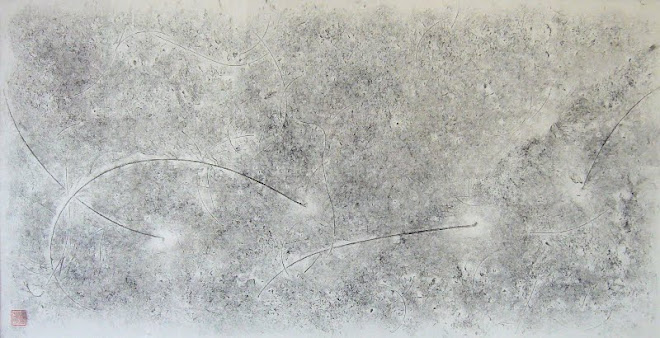
Recent Ink Rubbings and Pigment Works on Paper, China 2005 - 2008
18 September - 18 October
.
Opening Wednesday 17 September 6 - 9 pm
Performance "KISSES FOR SHANGHAI" Saturday 20 September 2 pm
"CHINA TALKS" Saturday 27 September 1 - 5 pm
"SHANGHAI SOUNDS & DINNER" Saturday 27 September 6 pm 'til late
.
left: "German Garden #1",
pigment on paper, 50 x 100 cm, scroll size: 70 x 210 cm, 12.2007, Fuzhou, China
.
.
.
Eschewing oil paint, Thomas Jacobi focuses his work on 'red' and white, brushing brick powder pigments freely on rice paper in strokes reminiscent of calligraphy but not recognizable as any characters in particular. In 2005 he was granted an Artist in Residence position in Fujian, China. During the months he spent investigating tradition within China, he also turned to the technique of frottage (tayin), which had long been used as a means of disseminating calligraphy engraved in stone surfaces.
In China, the scholars appreciation and collecting of ink rubbings of stone-carved calligraphies have a long history. In the West, the attempts of alchemists to discover the secret of making gold led to another understanding of science. Thomas seeks to find the appropriate way as a contemporary artist to transcribe or to transform material through the working process in the search for the essential.
In China, the scholars appreciation and collecting of ink rubbings of stone-carved calligraphies have a long history. In the West, the attempts of alchemists to discover the secret of making gold led to another understanding of science. Thomas seeks to find the appropriate way as a contemporary artist to transcribe or to transform material through the working process in the search for the essential.
"The ink rubbings document the use of objects by humans and the traces left in material. They tell the stories, record the signs and carvings of daily life, giving evidence of past and present. The pigments are made of stone, bricks or clay, any material used to construct housing. Houses give shelter to people and also record history; working with the pigments of historic buildings sets the pure substance of colour free… The material matters – in the service of concept." Thomas Jacobi

.jpg)
